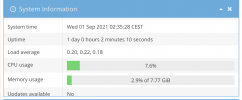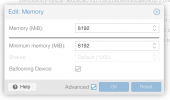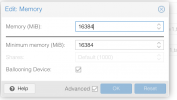Hi!
I'm using Proxmox 7.0. It reports that my openmediavault VM uses 95.32% (7.63 GiB of 8.00 GiB) or RAM, where OMV claims to be using 229M/7.77G.
OMV reports:

This is confirmed by:
However, proxmox claims that the memory is running out:

With the other VM, running ubuntu-server there's also misalignment: proxmox reports 20.38% (3.26 GiB of 16.00 GiB), where OS claims 2.1Gi - which is still worrisome, albeit not as much.
What's going on? How can I diagnose the issue?
I'm using Proxmox 7.0. It reports that my openmediavault VM uses 95.32% (7.63 GiB of 8.00 GiB) or RAM, where OMV claims to be using 229M/7.77G.
OMV reports:

This is confirmed by:
Code:
# free -h
total used free shared buff/cache available
Mem: 7.8Gi 213Mi 151Mi 13Mi 7.4Gi 7.3Gi
Swap: 9Gi 0.0Ki 9GiHowever, proxmox claims that the memory is running out:

With the other VM, running ubuntu-server there's also misalignment: proxmox reports 20.38% (3.26 GiB of 16.00 GiB), where OS claims 2.1Gi - which is still worrisome, albeit not as much.
What's going on? How can I diagnose the issue?



